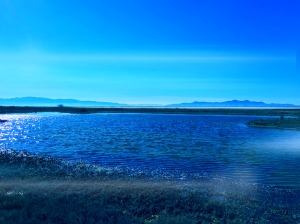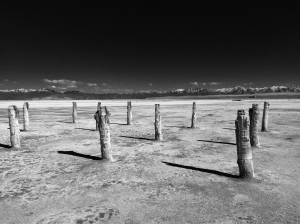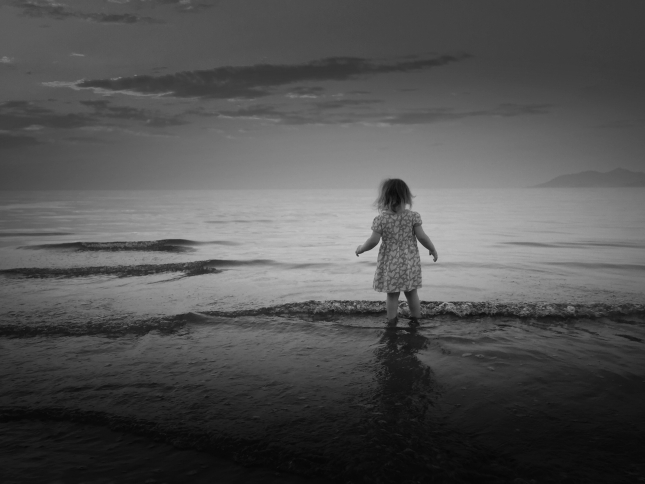
The Beach Boys at Saltair circa 1968 (via Google Images)
GREAT SALT LAKE, CIRCA 1968—
The exact dates are fuzzy, but Bill Hesterman, Jr. and his younger brother Dave remember their first trip to Saltair like it was yesterday.
It was early on a Saturday afternoon when their father, Bill Hesterman, Sr., pulled the family’s red Toyota Land Cruiser off Highway 40 and aimed it toward the lake’s southern shore. There, at the end of a mile-long trestle, stood Saltair—the world-famous “Lady of the Lake.”
Or Saltair’s ghost, at least.
The historic resort had been deserted for nearly a decade. The locked gate at the trestle’s entrance was a half hearted formality. The Utah State Parks Commission, to which the resort had been donated in 1959, had neither the resources to maintain the iconic pavilion nor an interest in restricting access to it. Saltair hosted throngs of recreationists and big-name musical acts for nearly 60 years before it succumbed to the elements, extraordinary operating costs, and an ever-receding shoreline. Now the dilapidated Moorish edifice appealed only to urban explorers and tourists who pined for its glory days.
It was those glory days that brought the Hestermans to Saltair that day. Bill and Dave sat in the back seat. Riding shotgun was The Beach Boys founding member Al Jardine, who was in town with his band mates to play a concert at Lagoon later that evening. Jardine was stoked to explore Saltair. Bill and Dave were stoked to be hanging out with their rock idol. Hesterman shifted into 4-wheel-drive, hopped the railroad tracks and cruised the alkaline mile out to the ghost resort.

The Beach Boys stand on pier pylons behind the abandoned Saltair Pavilion (via Google Images)
Even casual Beach Boys fans know the band’s connection to Utah runs deep. It’s well known that the band’s 1964 hit “Fun, Fun, Fun” was inspired by Salt Lake City teenager Shirley Johnson England, daughter of KNAK radio station owner Howard Johnson, who took her father’s Ford Thunderbird and naughtily cruised State Street. And of course there’s the 1965 song, “Salt Lake City.” The Beach Boys played Lagoon seven times during their formative years are set to headline BYU’s Stadium of Fire Independence Day celebration next month.
So what brought The Beach Boys to Utah in the first place? How did little ol’ SLC become The Beach Boys second home?
It all started in the early 60’s when Hesterman, then a DJ and general manager of KNAK Radio, played a rough Beach Boys demo tape on the air. “Daddy-O,” as Hesterman was known on-air, was likely the first disc jockey to play a Beach Boys record on radio outside of California.
And Utah listeners were smitten. As the fledgling band’s sunny lyrics and rich harmonies began to define the surf rock genre, Hesterman promoted them heavily. He arranged several Beach Boys concerts at Lagoon and later toured with the band in Europe.
Jardine reflected on those early Lagoon concerts in a 2010 interview in Goldmine Magazine:
“It was a magical time. It was like being in a time warp (I think). It felt like we were back in the 1940s and ’50s doing these big ballroom dances, which were so popular in that era.
“We set attendance records every year … it became an annual affair. That’s the kind of vibe we were having with our fans and [even] the promoters at that time. Everybody was pretty happy with The Beach Boys. It was reciprocal feeling, and we always set attendance records.”
He also talked about Hesterman:
“Bill Hesterman was the deacon in the Mormon Church — he never prophet-eltized (sic) or tried to push his particular faith on us. He was just a normal guy with a great radio voice and just promoted the heck out of The Beach Boys. That spilled over to the promoting of the Lagoon.”
Hesterman was actually a Mormon Bishop at the time, but I think we can cut Jardine some slack.
He became good friends with band and their manager, Murry Wilson (also the father of band members Brian, Dennis, and Carl). When the Hesterman family traveled to California, they visited the Wilsons. When the band was in Salt Lake, they hung out with the Hestermans. While the tune “Salt Lake City” was a public tribute to their Utah fans, it was written in Hesterman’s honor. And although “Barbara Ann” wasn’t written by The Beach Boys, they often dedicated SLC performances of it to Hesterman’s wife, Barbara.
The Hesterman children were given tour jackets and backstage passes to Beach Boys concerts, and were sometimes introduced by their father on stage.
Bill, Dave, and their younger brother Mark grew especially close to Al Jardine.
“I remember him picking me up as a little kid and holding me in his arms,” Mark Hesterman recalled during a phone interview earlier this week. “He always seemed to be well grounded, just a regular guy.”
Bill “Daddy-O” Hesterman remained close friend of the band until he passed away in 1996, and his sons still keep in touch.
But back to that Saturday at Saltair.
According to Dave, the outing had been Jardine’s idea. He had heard about the resort growing up and was intrigued by its musical heritage. With the Lagoon concert several hours off, Jardine saw an opportunity. They’d have plenty of time to tour the old pavilion before join up with the other Beach Boys for the concert.
They spent two hours wandering the pavilion and exploring underneath. They climbed the grand staircases. They walked to the middle of the dance floor, which for decades was the largest unobstructed dance hall in the United States. They stood there for a while, just to take it in. This was the place where generations of Utahns danced, fell in love, and thrilled to the music of the Mills Brothers, Phil Harris, and Nat King Cole.
“You felt like the ghosts of the bands were in the background,” Bill Jr. recalled.

Saltair featured the largest unobstructed dance floor in the U.S. (Utah Historical Society)
Though it was certainly run down, Bill Jr. said the old pavilion’s infrastructure seemed plenty solid—perhaps fully restorable with proper funding.
Leaving Saltair proved difficult when the Cruiser high centered on the railroad tracks.
“We were stuck out there in no-man’s-land,” Dave laughed.
Everybody got out and started to dig. They tried rocking the Cruiser and using a railroad tie for leverage. They worked for over an hour, racing against the clock and the darkening clouds and the next passing train. Bill Sr. was fretful. Jardine, according to Bill Jr., “thought it was great sport.”
They finally freed the cruiser and sped to Lagoon, arriving late to an anxious crowd. With no time to clean up, Jardine joined his band mates on stage covered in Great Salt Lake mud. By all accounts, the concert was great.
When Jardine told the other Beach Boys about Saltair, their interest was piqued. It was decided (with a measure of reluctance from Bishop Hesterman) that they would all return to Saltair on Sunday for a photo shoot before leaving town on Monday. On Sunday afternoon Hesterman, the band, and a photographer loaded into the Cruiser and drove west (Bill Jr. and Dave didn’t make the trip; Hesterman insisted they stay home and attend church services).

The cover of Unsurpassed Masters, Vol. 19 (via Google Images)
As reported in last week, the photos taken that day were featured on a European repackage of Today! and a later Sea of Tunes bootleg release. The guy in the middle of the cover shot? Yep, that’s Bill “Daddy-O” Hesterman.
Aside from those photos, little is known about the trip or the photographer. Calls to Al Jardine’s manager were not immediately returned (no shock there; the band is on tour and this is a modest blog). But Jardine did mention the trip in the same Goldmine Interview:
“In 1968, Bill took us out to the Salt Flats out there at another old ballroom called the Salt Palace that had since — literally — started to fall into the Salted Sea in the Great Salt Lake. In the 1940s, there was a dance hall out there. The lake shrank away and Bill thought it would be a great place to have pictures taken. So we were sitting on pier pylons and goofing around in the sand out there. You can imagine that the Salt Palace was a hell of a place, and it must have really rocked… The Lagoon was our Salt Palace.”
Okay, so his names are off (the Salt Palace is a convention center in downtown SLC and I’m not sure what he’s referring to with the “Salted Sea”), but it has been about 44 years. His comparison of Saltair to Lagoon is interesting since the two resorts were fierce competitors until the former’s demise. Lagoon had solid local appeal, but Saltair was a nationwide destination and was frequently dubbed the “Coney Island of the West.” The pavilion’s ornate Moorish design and location nearly a mile offshore gave it grand, almost ethereal presence. This setting, combined with the popularity of saltwater swimming and the resort’s massive dance hall, made Saltair THE concert destination. Had The Beach Boys been around even a decade earlier, they would have certainly played Saltair.
But their rise in prominence coincided with the end of the Saltair era and the beginning of Lagoon’s heyday. Lagoon, as Jardine aptly points out, was the Beach Boys’ Saltair. How appropriate that they, thanks to Bill “Daddy-O” Hesterman, were able to visit both over the same weekend!
——-

Those same pylons today (photo by Clint Thomsen)
Click here for my previous stories about Saltair.
UPDATE: Just for fun, a few more photos from a visit on 3/13/2015:




 Last summer I was contacted by BYU Broadcasting to provide commentary for a new documentary about Great Salt Lake and Saltair. I had a wonderful time working with Director Rob Sibley and his crew, and I think the documentary turned out great.
Last summer I was contacted by BYU Broadcasting to provide commentary for a new documentary about Great Salt Lake and Saltair. I had a wonderful time working with Director Rob Sibley and his crew, and I think the documentary turned out great.























 Posts RSS
Posts RSS Comments RSS
Comments RSS